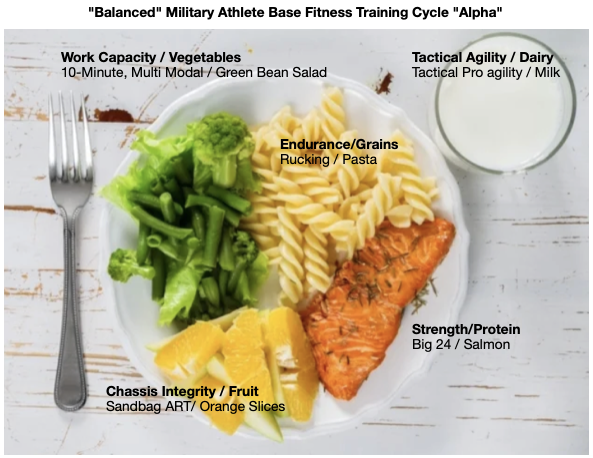By Rob Shaul
MTI has two types of programming: (1) “Base” Fitness programming, and; (2) Event and/or Sport Specific Programming.
“Base” Fitness programming is our day-to-day programming. Examples include the Greek Hero Plans for Military Athletes, Spirits Plans for LE Patrol/Detective, Greek Heroine Plans for multi-sport mountain athletes and Tragic Wildfire Plans for wildland firefighters.
 MTI’s Event and/or Sport Specific programming is narrow, focused programming specifically designed to prepare athletes for a specific event or sport such as a military PFT, selection or course, or a specific mountain event such as climbing Denali, completing a Rim to Rim Hike in the Grand Canyon, preparing for ski season or training for a Half Marathon.
MTI’s Event and/or Sport Specific programming is narrow, focused programming specifically designed to prepare athletes for a specific event or sport such as a military PFT, selection or course, or a specific mountain event such as climbing Denali, completing a Rim to Rim Hike in the Grand Canyon, preparing for ski season or training for a Half Marathon.
It’s counter-intuitive, but MTI’s Base Fitness programming is more advanced and difficult to design than our event and/or sport specific programming. There are several reasons for this.
First, base fitness programming for the athletes we cater is multi-modal.
The intent of Base Fitness programming is to build a mission-direct level of fitness in the athlete for the day to day requirements of their job, and also as a “foundation” of fitness upon which to build event and/or sport specific fitness if needed.
Base Fitness programming is multi-modal because it reflects the multi-modal, mission-direct, fitness demands of the athletes we work with. Mountain athletes, for example, require a solid level of mountain endurance (trail running, uphill movement under load), total body strength, chassis integrity, grip-specific climbing fitness, and work capacity.
Military athletes such as infantry need military endurance (run, ruck), high relative strength, chassis integrity, sprint-basked work capacity, and tactical agility.
So, each Base Fitness programming cycle must train each of these “modes” for the respective athlete type.
Second, Base Fitness cycles can be “balanced” across all fitness modes, or apply cyclic emphasis to one or more mode.
We do this both ways, and often swap back and forth between “balanced” Base Fitness cycles and Base Fitness cycles which have “cyclic emphasis.”
Below is the training schedule example of a “balanced” military cycle which concurrently trains military endurance (run, ruck), work capacity, chassis integrity, strength, and tactical agility.
- Mon: Strength, Work Capacity
- Tue: Endurance (Run)
- Wed: Tactical Agility, Chassis Integrity
- Thurs: Strength, Work Capacity
- Fri: Endurance (Ruck)
Below is the training schedule example of a “cyclic emphasis” military cycle which has a slight endurance emphasis:
- Mon: Strength, Work Capacity
- Tue: Endurance (Run)
- Wed: Tactical Agility, Chassis Integrity
- Thurs: Endurance (Run + Ruck)
- Fri: Endurance (Ruck)
Third, Base Fitness programming must combat the “staleness” caused by the “Burden of Constant Fitness.”
All tactical athletes, and professional mountain athletes share the “Burden of Constant Fitness.” This simply means because the nature of their occupations, they can never let their fitness go – they need to constantly be in mission-direct shape, and this means they must constantly be training. This need to be constantly training, especially over a long 20-40 year career – can be a “burden.”
This “staleness” comes at the athlete from two directions: (1) fitness, and; (2) mental.
From the fitness perspective, if an athlete trains for strength using the same exercises and the same progression methodology all the time, eventually he or she will “plateau” and even regress as his body accommodates to the programming impetus.
Something similar happens mentally, as well – without changing things up, the fitness training becomes “stale.” I hear this all the time from military squad team members, who reach out for programming alternatives because they are simply sick of doing push ups, pull ups, sit ups and running every day. Mentally, this type of fitness programming has become “stale” and they need a change.
The goal of MTI’s “Base Fitness” programming is not constant improvement across all training modes. Why? First, from a fitness programming perspective, at some time, to continue to improve in one mode of fitness, that mode of fitness must be given more and more training time – and this costs training time, and therefore fitness, in the other modes. For example, at some point following MTI Base Fitness programming, most athletes will quit getting stronger. Their strength increases will plateau, and the only way I can break through his plateau is to put more and more emphasis on strength in the programming, but this comes at the expends of other fitness modes like work capacity or endurance.
So, by putting more emphasis on strength, I can get the athlete stronger, but his work capacity and endurance will decline while I’m doing so … and he his mission demands work capacity and endurance in addition to strength.
Also – and this is important – military athletes are not strength athletes, and mountain athletes are not endurance athletes. Certainly strength is a mission-direct demand of military athletes, but an infantryman or green beret does not need power-lifting competition-level strength to do his/her job. Likewise, endurance is a major component of all mountain movement, but a mountain athlete is not a competing triathlete or professional distance runner. Mountain athletes need strength and chassis integrity for carrying packs and other equipment, and might need short, intense work capacity summit before the lightening storm starts, or make it quickly did a snow cave before the blizzard arrives.
Base Fitness programming can also become “stale” mentally. Base fitness programming for Law Enforcement Athletes must include strength training, but I don’t need to program strength training using the same exercises and same progression methodology every base fitness training cycle. In fact, one of the reasons I’ve developed nearly 10 different strength training methodologies over the years is to address the mental staieness of constantly having to train strength. The methodologies in this article doesn’t include the various ways I’ve developed to train strength using bodyweight only, or sandbags only, or complexes only, or our new Big 36 progression.
I’ll manipulate programming in other modes to combat fitness accommodation and mental staleness as well. For example using assessed and progressed running or rucking events, or step ups for time to train endurance. Switching up between bodyweight and loaded chassis integrity programming, and manipulating modes, and methods to train work capacity.
This “constant change” in programming specifics is layered on top of the fundamental basics of base fitness programming (multi-modal, mission-direct) in an attempt to ensure the athlete has a high level of base “mission-direct” fitness, isn’t regressing in fitness, and is mentally engaged.
So What Does This Have to Do With a Food Menu?
One way to conceptualize MTI’s base fitness programming approach, and how we address emphasis (balanced or cyclic) and the burden of constant fitness (accommodation and staleness) is to think about the 5 major food groups and a plate of food.
The Base Fitness “modes” we train for military athletes are: Strength, Work Capacity, Chassis Integrity, Endurance and Tactical Agility.
The 5 Major Food Groups are: Protein, Vegetables, Fruit, Grains and Dairy.
The examples below are two “balanced” base fitness cycles or “balanced” multi-week diets, where all fitness modes are trained and all food groups consumed, in fairly equal amounts during the multi-week cycle.
For each cycle, the athlete trains strength, work capacity, chassis integrity, endurance and tactical agility, and each menu, he eats protein, vegetables, fruit, dairy and grains. However, the training mode methodologies and actual foods deployed for each cycle/menu is different.
So … we’re training the “base fitness” of this military athlete, but addressing training “staleness” (fitness and mental). And we’re getting him fed, but adding in some variety.
Questions? Email coach@mtntactical.com
Comments? Please enter your comment below.
STAY UPDATED
Sign-up for our BETA newsletter. Training tips, research updates, videos and articles - and we’ll never sell your info.


